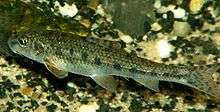Gobio gobio
Gobio gobio, or the gudgeon, is a species of fish in the family Cyprinidae. This small fish is widely distributed in fresh-water streams and lakes across central and temperate Eurasia.
| Gobio gobio | |
|---|---|
 | |
| Scientific classification | |
| Kingdom: | Animalia |
| Phylum: | Chordata |
| Class: | Actinopterygii |
| Order: | Cypriniformes |
| Family: | Cyprinidae |
| Subfamily: | Gobioninae |
| Genus: | Gobio |
| Species: | G. gobio |
| Binomial name | |
| Gobio gobio | |
| Synonyms | |
| |
The gudgeon inhabits all kinds of fresh-water habitats with sandy bottoms. It is a gregarious species, and feeds on benthic invertebrates. Its life span is up to five years. Gudgeons are usually smaller than 12 cm, rarely over 15 cm long. The common name gudgeon may also refer to other species of fish.
Description
The gudgeon has a long, slender, rounded body and is typically 9–13 cm (3.5–5.1 in) long,[2] but can reach up to 21 cm (8.3 in).[3] It has short dorsal and anal fins that do not have serrated rays. There is a labial barbel at each corner of its mouth. It has two rows of pharyngeal teeth, conical, and slightly curved at the tip. Its head is wide and flattened, with a rather obtuse snout, the lower jaw being shorter than the upper one. It has relatively large scales and there are 40 to 45 of these along the lateral line. Its swimming bladder is large. Usually greenish brown above and silvery on the sides, this fish has a row of six to twelve faint dark blotches running along the flank. It has a white underside, and its pectoral, ventral, and anal fins are of a grayish-white color with a brownish tinge. The dorsal and caudal fins are pale brown with darker spots.[2]
Distribution and habitat
The gudgeon is present in freshwater systems that drain into the eastern Atlantic Ocean, the North Sea and Baltic Sea basins. These drainages include the Loire drainage and the drainages further east, the eastern Great Britain and Rhône drainages, the upper Danube and middle and upper Dniestr, the Bug and Dniepr drainages in the Black Sea basin. It is unclear how far into Asia its range extends. It is typically found in lakes, rivers and streams of all sizes that have sandy or gravelly bottoms.[1]
Behavior
The gudgeon moves in shoals over sandy and gravelly bottoms, feeding on worms, aquatic insects and larvae, small mollusks, ova, and fry. It is normally active during the day. It is capable of emitting squeaking sounds, which are believed to be a means of communication between individuals. It breeds in shallow waters over stones. Eggs are laid from April to August, when water temperatures are above 13 °C. The eggs are released above the substrate and drift with the current becoming attached to the bottom. The larvae and juveniles feed on detritus on the bottom.[1] The fingerlings grow to some 12 cm (4.7 in) in the first year and this fish can live for up to five years. The species is much valued for its delicate flavour.
Predators
The gudgeon is a common prey of many fish-eating predators like Eurasian otter or common kingfisher. In Central Europe, on streams and rivers, gudgeon composes up to 45% of the diet of common kingfisher (by numbers, usually between 25-35%) and represented the most hunted fish prey.[4][5][6] One study has shown that gudgeon composed over 80% of the diet of otter by numbers and over 50% of the diet by weight (Chotýšanka stream, Central Bohemia, Czech Republic).[7]
Status
The gudgeon has a wide range and is abundant in many localities. It faces no particular identified threats so the IUCN has listed it as being of "Least Concern".[1]
References
- Freyhof, J. (2011). "Gobio gobio". The IUCN Red List of Threatened Species. IUCN. 2011: e.T184448A8277959. doi:10.2305/IUCN.UK.2011-1.RLTS.T184448A8277959.en.
- "Gudgeon: Gobio gobio". NatureGate. Retrieved 14 December 2013.
- Froese, Rainer and Pauly, Daniel, eds. (2016). "Gobio gobio" in FishBase. August 2016 version.
- Čech, M., Čech, P. (2013). "The role of floods in the lives of fish-eating birds: predator loss or benefit?". Hydrobiologia. 717 (1): 203–211. doi:10.1007/s10750-013-1625-3.CS1 maint: multiple names: authors list (link)
- Čech M., Čech P. (2015). "Non-fish prey in the diet of an exclusive fish-eater: the Common Kingfisher Alcedo atthis". Bird Study. 62 (4): 457–465. doi:10.1080/00063657.2015.1073679.
- Čech M., Čech P (2017). "Effect of brood size on food provisioning rate in Common Kingfisher Alcedo atthis". Ardea. 105 (1): 5–17. doi:10.5253/arde.v105i1.a3.
- Lyach R., Čech M. (2017). "Do otters target the same fish species and sizes as anglers? A case study from a lowland trout stream (Czech Republic)". Aquatic Living Resources. 30 (11): 7. doi:10.1051/alr/2017011.
